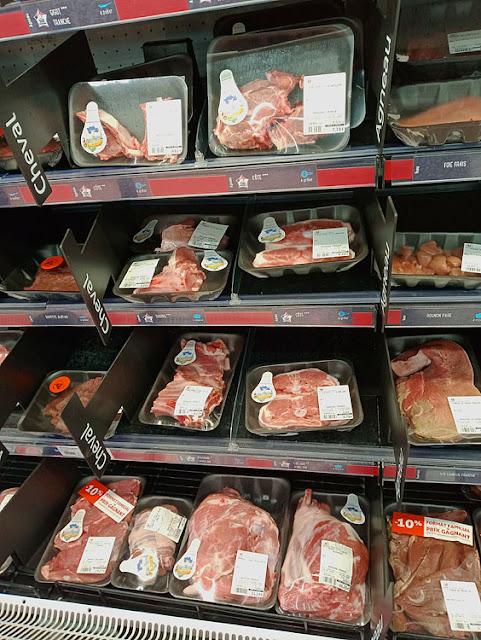Agneau de Poitou-Charentes (Poitou-Charentes lamb) is an IGP (Indication Géographique Protégée or Protected Geographical Designation) certification label for quality lamb produced in Poitou-Charentes, and covers a quarter of total lamb production in France. Agneaux des Bocages is a sub-group of this IGP, and concerns extensively raised lamb on the traditional pasture system known as bocage. The sheep graze in small fields surrounded by hedges and it is a sustainable way to raise livestock and benefit biodiversity. It is not just the meat which is certified, but the fleece and hide as well.
 |
| Bocage lamb at our local supermarket on Friday (and yes, that is the horsemeat section to the left). The lamb is priced at between €17/kg and €27/kg, depending on cut. |
Lamb produced in the départements ('counties') of Charente, Charente-Maritime, Deux-Sevrès and Vienne can have this certification. We live in Indre et Loire but 10 minutes from the border with Vienne, and the supermarket I shop at is in Vienne, so every year I look out for the Agneaux des Bocages, because it's sustainable, affordable and local. Like many other products in France it is seasonal, not available all year round.
 |
| Sheep and wild Lady Orchids Orchis purpurea (Fr. Orchis pourpre) share the bocage. |
Despite its importance as habitat, bocage is not protected per se, and is disappearing. The principal areas still using this type of pasture system are a band north-east of Angouleme and south-east of Poitiers, around Montmorillon and to the south; and between Niort and Poitiers, around Saint Maixent l'Ecole, Parthenay and Bressuire, to the Atlantic coast.
 |
| Sadly, this is what bocage often gets turned into now. Most farms have switched from grazing animals to growing crops (wheat, grapes), and in this case, poplar trees. |
Sheep have been an important part of the agricultural sector in Poitou-Charentes since medieval times. Initially they were primarily grown for their wool, but these days it is the meat that there is a market for. By the 19th century, the plains north of the Loire in the Paris Basin had abandoned their mixed sheep and cereal production and concentrated solely on grain production. In contrast, the land south of the Loire and to the west, which was more difficult to plough and couldn't be converted to intensive farming techniques, primarily grazed sheep. But from the 1960s the land around Poitiers to the south and west was being ploughed up to grow wheat, maize and canola, and a third of the hedges grubbed up. The area of land in Poitou-Charentes that has never been ploughed has more than halved since 1960, and a quarter of the ponds have disappeared. Bocage is rather damp and lush habitat, one reason why it is so important, and why the change to intensively farmed cereal 'deserts' is so undesirable from an ecological point of view.
 |
| Aubrac cattle in a well managed traditional bocage field. |
I always like to support the small group of sheep farmers who are dedicated to maintaining the bocage and if I'm not buying lamb produced within a few kilometres of my house, I will buy the next best thing, from a bit further away, but still local and sustainable.

No comments:
Post a Comment